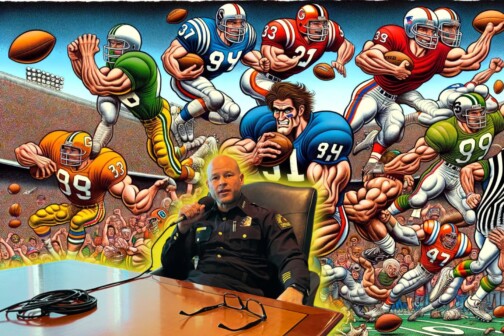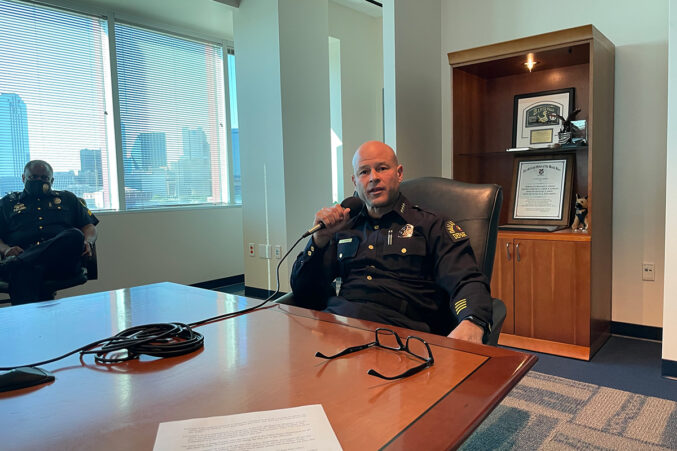Harwood Park opened Saturday morning and its first visitors awaited official remarks during a ceremony that felt at times more solemn than celebratory. The dreaded term “concrete jungle” was used to describe the previous sorry state of the area. As with many public transformations in this city, there were dichotomies in full focus: public and private; Democrat and Republican; green space and concrete; basketball and pickleball; all-access and VIP.
Some of these contrasts bore mention in the chuckling remarks delivered by the officials, not the least from Mayor Eric Johnson, who attended the ceremony less than 24 hours after announcing he had switched his party affiliation. People clapped as hard as they could, like divorced parents grinning through a birthday party. After four years of planning and construction, it was showtime. Public ceremony waits for no one and no thing.
Harwood Park is the fourth and final “neighborhood park” opened by the Downtown Dallas Parks Conservancy, the nonprofit that recently rebranded from Parks for Downtown Dallas and shifted its purpose from builder and fundraiser to maintenance and operations.
The shadow thrown by the building at 312 South Harwood Street was the only relief from the sun for the well-dressed and well-connected crowd who were eager for this immense step forward in the evolution of the city’s park system. At the cost of only a handful of veteran buildings and at least one tree that refused to die, four new acres are now open to the public on the east side of downtown. The space includes two dog parks, a splash pad with shooting fountains, and a gated court. There is plenty of green grass. Harwood Park includes an arts and entertainment stage for performances. In the middle of what was once excessive parking lot blight, Harwood Park is jarringly nice, new, and gleaming.
The Harwood project received a $1 million bump from Todd Interests, the developer responsible for rehabilitating old buildings and building new towers in this stretch of downtown that it has coined the East Quarter. At the hyper-local level, Todd Interests is very much into the idea of a public park, while the organization continues a very unsavory battle with Texas Parks & Wildlife over its purchase of Fairfield Lake State Park, which it plans to turn into a luxury subdivision 100 miles from downtown.
Branding firm Tractorbeam was tapped to handle the look and feel of East Quarter, where it was once headquartered. The agency’s executives say they were presented with a new lease at a significantly higher price point, leading them to look elsewhere. It meant one of the hip, non-corporate tenants that Todd Interests intended to attract eventually relocated to the Cedars.
All the parks and rec action downtown is meant to encourage easy access between Deep Ellum, downtown, and the Cedars while also lubricating surrounding real estate acquisitions. A million bucks to the emerald entrance of East Quarter from Todd is fiscally pragmatic.
The two day-opening weekend for Harwood could be described as unseasonably warm, but maybe it will just be this hot forever. The unfenced European-styled playground features two wooly mammoths as interactive public sculpture, a tribute to the beasts that once roamed this land. The mammoths were eventually followed by the era when the Comanche, Caddo, Cherokee, and Wichita tribes lived in North Texas. Tulsa, Oklahoma’s Gathering Place comes to mind with similar animal-themed, child-delighting features. It is fascinating to see this happening in this stretch of downtown. The physically imposing grassy footprint is a royal green carpet for the high-rise developments that will follow and for the people who live and work here.
There are now two basketball courts within walking distance of each other, which is a welcome change, but the pickleball fad threatens to complicate the fun distribution. Even so, Dallas basketball kids were already clogging up the courts. One of the nets was already a bit shredded on opening day—a welcome sight.
On Sunday, the general public was invited for food trucks, a DJ, live music, and the ubiquitous canned espresso martinis from Aprés Hours. Inexplicably, a “VIP on the Green” section separated wristband holders and sponsors from the average dog walkers not seeking a day-club experience in the middle of a city park.
DJ Sudaka of Dallas booking entity Chasquis Group played an international grab-bag of music during the day on Sunday. Live talent provided by the Dallas Symphony Orchestra and Anita Martinez Ballet Forklirico, as well as the Dallas-themed soundtrack (Leon Bridges, Polyphonic Spree) was clearly handled with care and attention. The stage itself could not handle the power load with the proper amount of wattage, so the breakers were tripped on Sunday more than once. A power generator was quickly procured; this issue will hopefully be resolved by the next time Harwood Park has a large-scale public presentation.
The metal hoops that adorn the roof of the performance area provide almost no cover from the heat and sun. (“How long do you think this installation lasts?,” asked an attendee under his breath.) The rings were frequently swiped when they were still part of the Statler’s parking garage before being repurposed for this stage.

Harwood Street has long been a challenge for downtown. In a 1988 feature on the street by Dallas Morning News architecture critic David Dillon, the writer describes the structure as “an anonymous concrete block parking garage, dressed up in gold rings and flashing lights like a bad Las Vegas nightclub act. Every downtown needs one of these to keep the “taste police’ occupied.”
Harwood Park has a structure on-site for the other kind of police to operate, as well as rentable space for private events. Dillon writes eloquently about the state of the street 35 years ago with one glaring miscalculation in his prediction:
But who cares? Harwood has been mauled so badly in the past that the answer appears to be no one. An inventory might show three buildings demolished for every one left standing, and the city is compounding the problem by clearing even more land around the Farmer’s Market. There soon may be no market left, but parking is going to be a breeze.
There is very much a market left and parking is anything but breezy. With the addition of what could very well be a highly popular new local meeting spot, parking may only become more of an issue, but likely a welcome one for both Todd Interests and the Downtown Dallas Parks Conservancy. The park, more than anyone, is for the denizens of downtown. Most of these folks won’t be in cars.
Finally, one micro eulogy for a beloved Dallas landmark. The United Artists door on the back of the art deco building that faced the street and provided the shade to the inaugural crowd on Saturday morning appears to have disappeared.
This little part of downtown was once a very remote distribution hub for Hollywood, supplying the area with miles of film and buckets of concessions. Film industry figure John L. Franconi ran his Capitol Pictures firm out of 312 South Harwood in the 1950s. I’ve long had a little heart pang for the UA door.
I would go and admire it after stumbling off from catching a game or DJ set at nearby Green Door or Harwood Tavern. It was like finding a partner’s old cheerleading squad pic or war memorabilia medal. This was you, Dallas? You once lived that large? Believe it.
And now with Harwood Park, the future of this area is in full view.
Author






